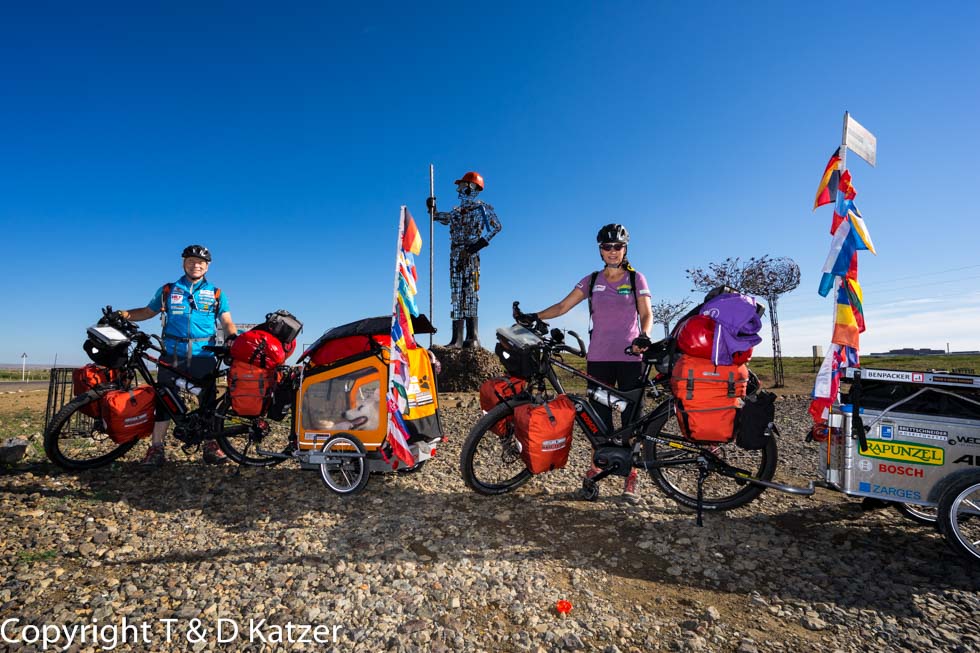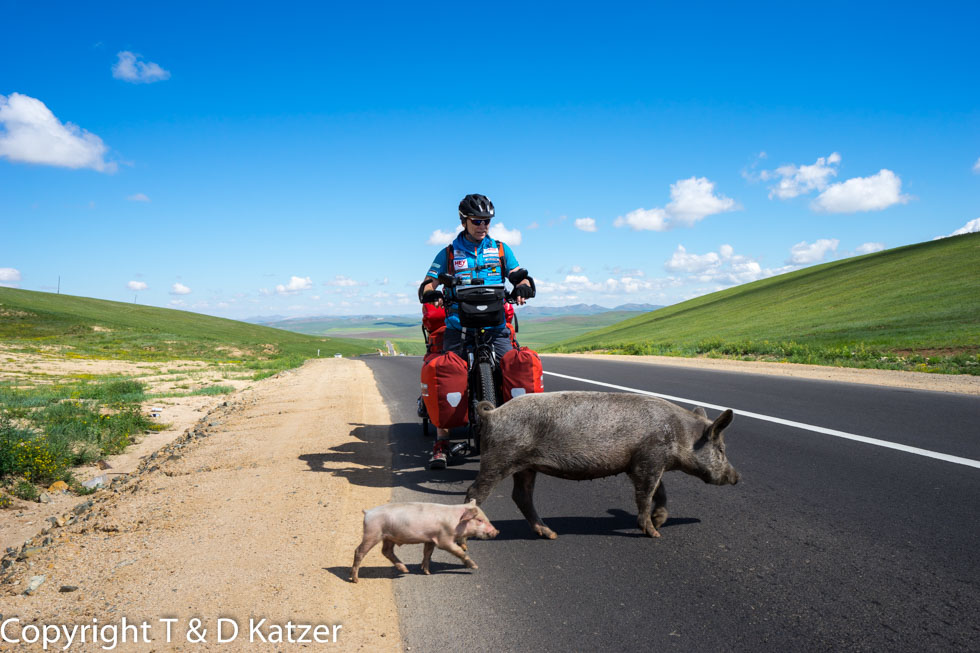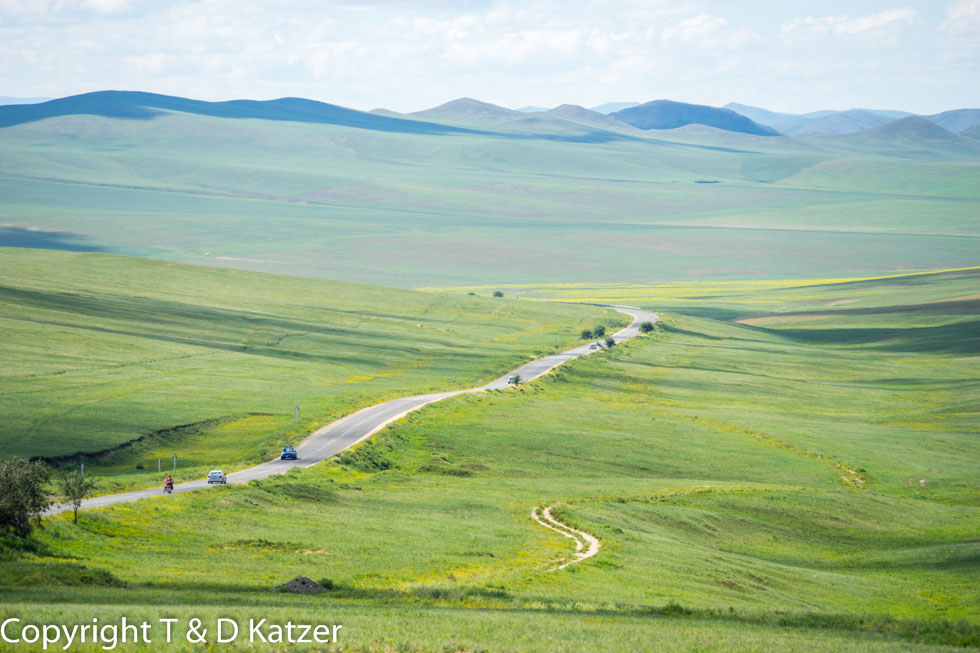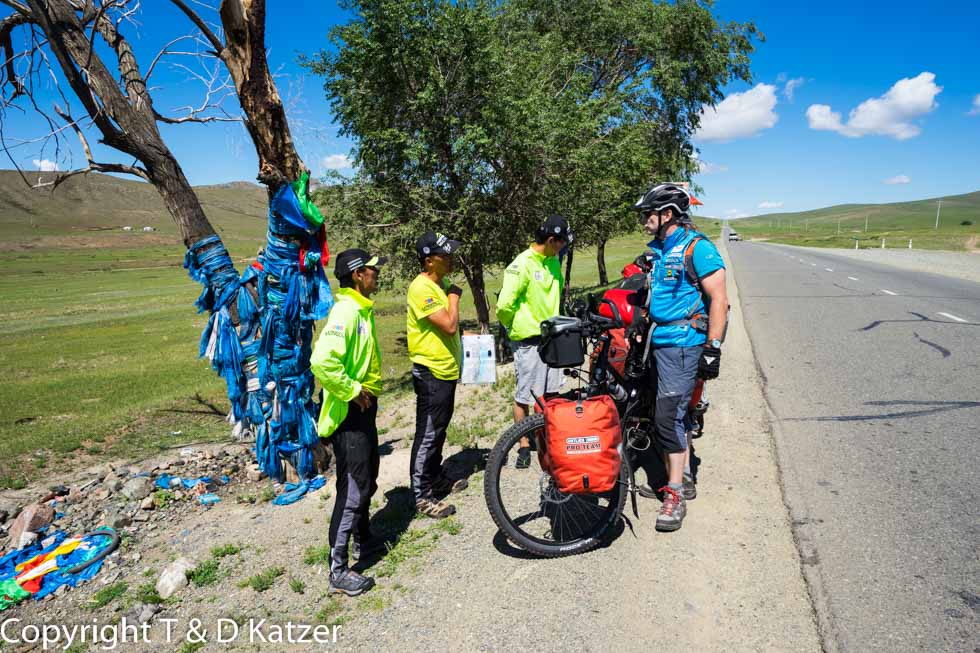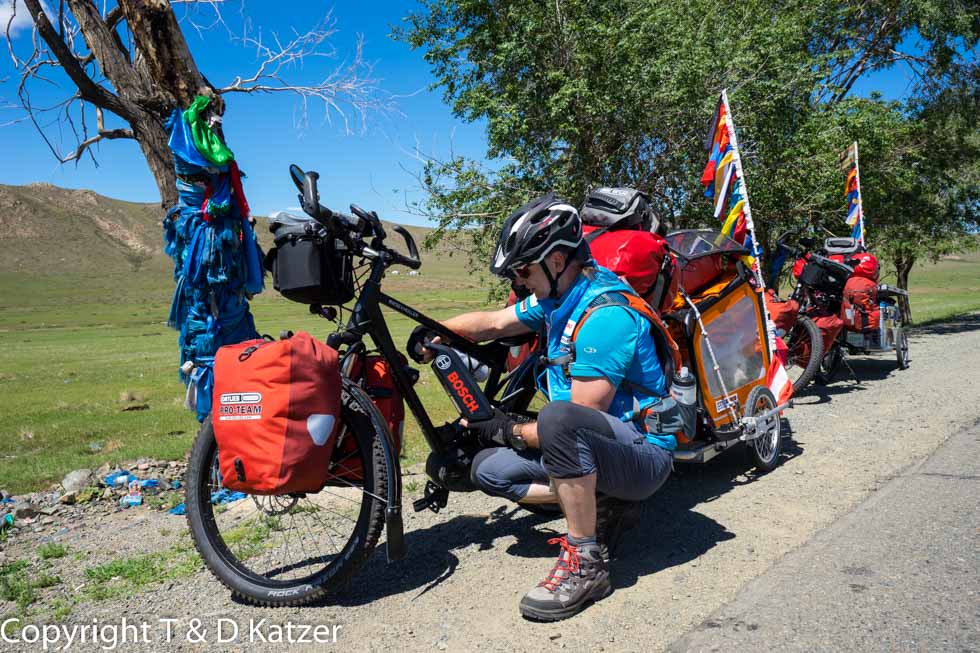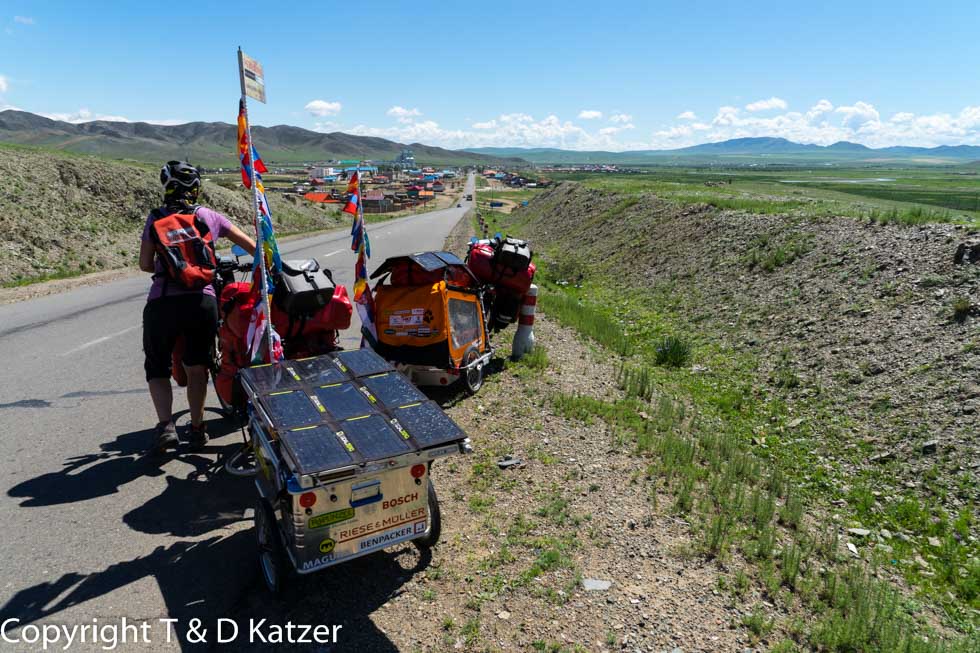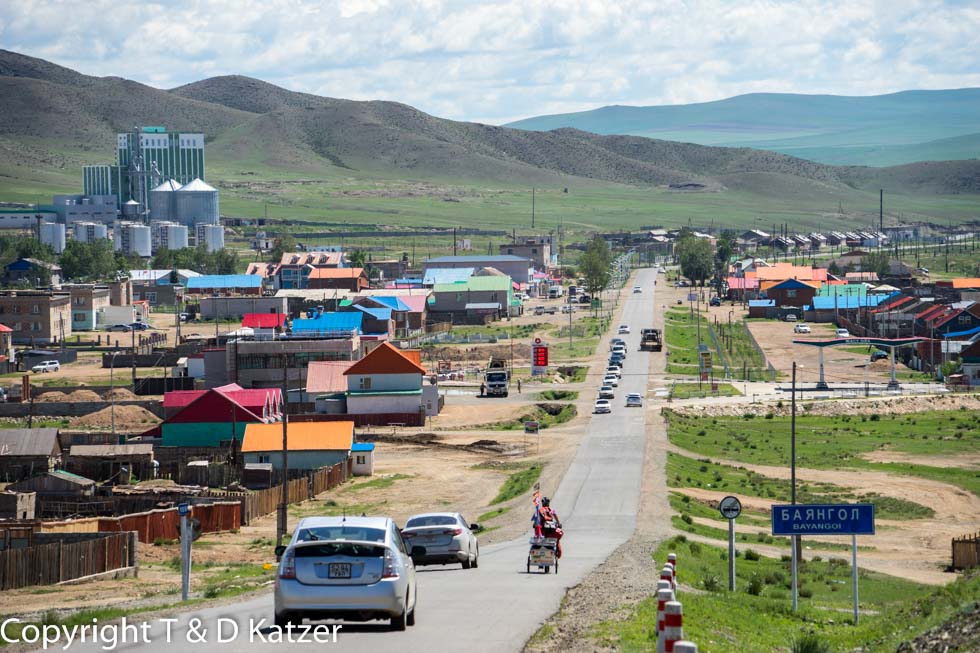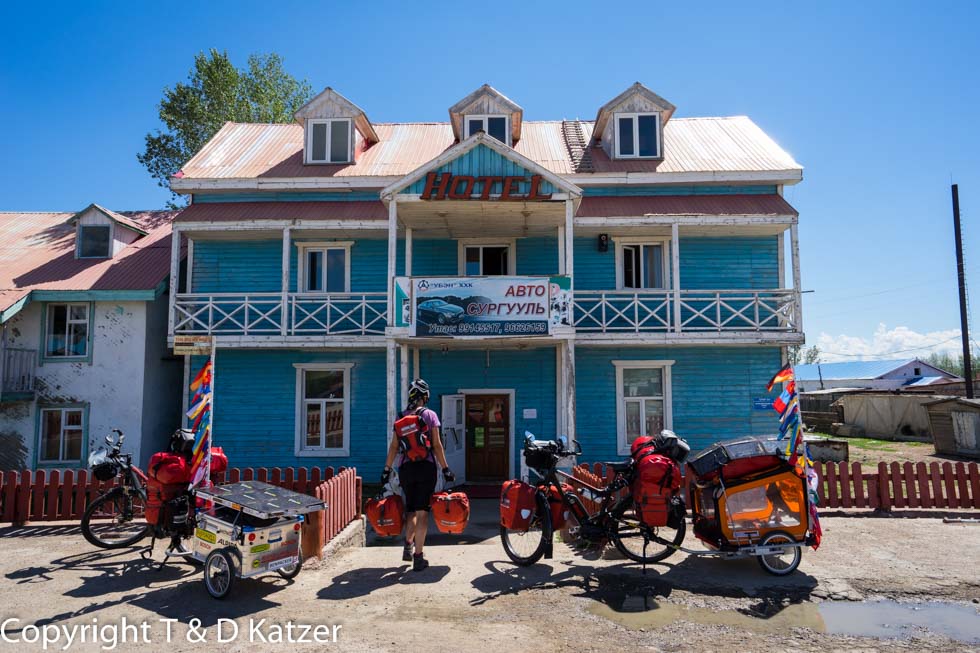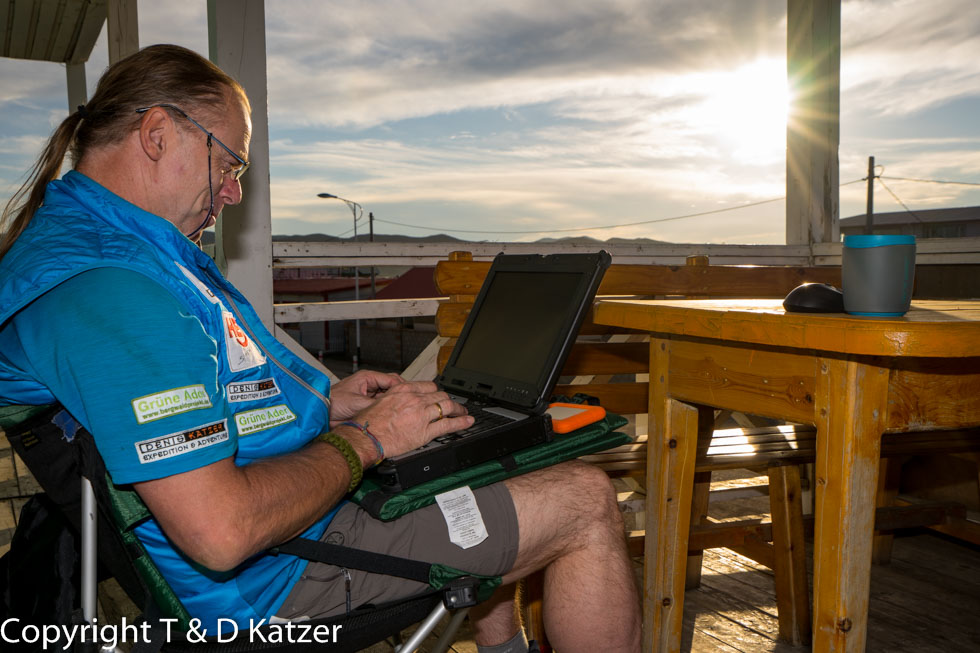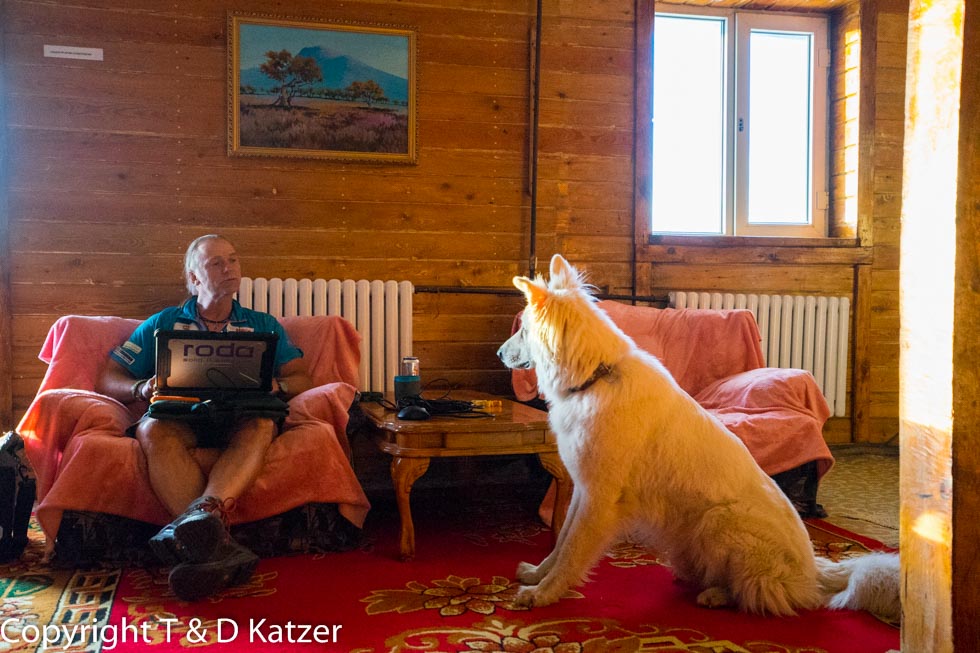
Charging technology and solar
N 48°54'44.0'' E 106°05'09.2''
Day: 38
Country:
Mongolia
Location:
Bayangol
Camp:
Latitude N:
48°54’44.0”
Longitude E:
106°05’09.2”
Kilometers per day:
72
Total kilometers:
8,393
As the crow flies:
64
Aver. Sib.
22.2 km/h
Maximum speed
52 km/h
Travel time hrs
3:13
Ground conditions:
partly poor asphalt
Maximum height:
990 meters
Temperature day max:
30 degrees
Departure:
8:15 a.m.
Arrival time:
2:00 pm
(Photos of the diary entry can be found at the end of the text).
It’s 6:00 a.m. We load our bikes. None of the street children are to be seen for miles around. Probably too early for adventures in the city. To remember our stay here, we take a few more photos in front of the large Buddha statue, then we let the pedal cranks spin towards Ulan Bator in the best weather. Traffic has increased dramatically. Asian Highway 3 is no longer the lonely road it was a few years ago. We have to concentrate on staying on track. In some places the edge of the road to the hard shoulder is quite steep, so we are worried that the trailer could tip over if the right tire comes off the road. Suddenly we see an unfamiliar silhouette in front of us. As we approach, we recognize two cyclists. Steve and Marco come from the Italian-speaking part of Switzerland. They transported their bikes by plane to Ulan Bator and are traveling through the country for three weeks. We briefly exchange a little information, take photos of each other and then continue our journey in different directions a little later. In the meantime, the e-bikes are climbing up to 1,000 m. The engines continue to support us without a hitch. After 30 km, I swap the battery and plug it directly into the Goal Zero battery, as I did during the last few days of the trip. Based on my many years of experience with solar technology, I put together a charging system in Germany consisting of 60 watt panels and the Goal Zero Yeti 150 solar generator. The buffer battery (Goal Zero) is responsible, among other things, for storing the energy generated by the solar panels and passing it on to the batteries in a smoothed form. If we were to connect the Bosch batteries directly to the solar panels, we would jeopardize the 12-volt power supply units due to the constantly changing charging voltage. They would simply be overloaded after a while. So when a Bosch battery is empty, I immediately connect it to the Yeti 150, which is then charged by the solar panels while I’m driving. The idea was that while a Bosch battery was charging, the buffer battery would be fed by solar power at the same time. However, the solar energy is not enough to keep the Goal Zero’s charge level constant. For this we would need a larger solar surface with more watts. However, the generator is able to charge the Bosch battery to three quarters full. Then it is at the end of its capacity despite solar power. We could also have taken two larger Goal Zeros weighing around 13 kilograms with us to avoid the problem of rapid discharge. But as we transport everything ourselves and have no support vehicle with us, we had to make compromises. Despite everything, the buffer batteries have enabled us to extend our radius of action in mountainous terrain by around 20 kilometers. With our three Bosch batteries (30 km per battery with a heavy load and many hills), an intermediate charge in a roadside restaurant and the additional charge from the buffer battery (20 km per battery with a heavy load and many hills), we currently have a range of approx. 140 kilometers. This current experience results exclusively from the local geographical location and the additional charging of a battery at a socket. For us, this radius of action is downright surprising and exceeds all expectations. Let’s see what experience we gain on the route ahead and how the range changes as a result.
I’m just changing battery 2 to insert battery 3 when a minibus with bicycles piled up on the roof rack roars past. “They must be tourists,” I think as the bus brakes. Three men in bright yellow jackets get out and come towards us. They are interested in where we come from and where we are going. “We’ve been on the road with our bikes for three weeks,” they say when we ask why they have loaded so many bikes. “Three weeks?” I wonder, as I had never expected Mongolians to go on longer bike tours and enjoy it. “Yes, three weeks. We drove along Lake Khovgol in the north and then crossed the border into Siberia to Ulan Ude. From there we were picked up by our driver. We had a few Korean tourists with us.” “So you’re an agency that offers bike tours for tourists?” “Yes, it’s a good business. More and more cyclists from all over the world are coming to Mongolia to experience and explore the country in this way,” says Khadbaatar, the head of the agency, laughing. “If you come to Ulan Bator, please call me. It would be nice if we could meet there,” he says while his son keeps filming and photographing us. “If we have time, we’ll be happy to come,” I say and shake the men’s hands goodbye.
After 73 km we reach the village of Bayangol, which is brutally split in two by the dusty and broken Asian Highway 3. To the left and right of the main arterial road, you can see shabby huts and small houses brooding away in the afternoon heat. We find the small, wooden hotel we’ve stayed in before. “Abandoned,” I say disappointedly, shaking the locked door. “There’s a phone number on the post. Maybe we should give them a call,” Tanja suggests. “Hm, the store looks very run-down now. I think they’ve closed down. But we can give it a try. “Yes, our hotel is still open. The room costs 45,000 (20,- €) Tugrik”, I hear the male voice on the other side of the line in surprisingly good English. “45,000 tugrik? Surely that must be a luxury room?” I wonder at the price. “Yes, it’s a luxury room. It doesn’t matter how many people move in.” “There are only two of us and we want a normal room.” “Costs 30,000 tugrik. (€13.55) The toilet is in the corridor.” “We’ll take that,” I say, happy to be able to stay here after all, as I don’t feel the slightest desire to walk a long way on this hot day to find a place to stay for the night.
Due to the risk of theft, we bring the bikes indoors as usual. After they are unloaded, I lock them together with a steel cable. I secure them to the iron heating pipes with another cable. We bring our equipment into the small room which resembles the parlor of an alpine hut. Tanja puts a large bowl of water in front of Ajaci. Then we leave the accommodation, of which we are the only guests, and look for a restaurant. “On the dusty main road, the passing cars stir up even more dust, which covers everything like a film and gives the colors of the huts, yurts and houses a grayish hue. With a little imagination, you could be forgiven for thinking we were in the Wild West. The small roadside restaurants, some with hand-painted or poorly printed signs above the entrance, are empty. “Doesn’t look very inviting,” I say skeptically, as I have lost all faith in such small wannabe restaurants since my food poisoning. We walk to the end of the village without finding anything where we could satisfy our craving for bikes. “That could be a restaurant up there? Look, there are even people in there,” I say, pointing to the many dingy windows on the second floor of a relatively new building. In fact, the premises turn out to be a very busy Mongolian fast food restaurant. Using sign language and pointing at the food of other guests, we tell the woman behind the till what we want. Within a few minutes we are served a tasty goulash with salad. “Who would have guessed that in such a small settlement,” I say, rubbing my stomach with satisfaction.
The sun is already low as I make myself comfortable in my old camp chair on the dilapidated, wooden balcony of the accommodation to write down the day’s experiences. Suddenly my Word program crashes and the work of the last hour is irretrievably lost. Fiddling around with technology has been very exhausting for years, in addition to the challenges of traveling. Sometimes a program suddenly doesn’t work as it should, an update can’t be downloaded, a hard disk or camera gives up the ghost, a cable breaks, a fuse blows and, in the worst case, an electronic part simply dies without being able to be brought back to life. The adventure of technology is just as uncontrollable as the adventure of life. The two together sometimes create an arc of tension that can only be smoothed out with calmness and inner peace.
The live coverage is supported by the companiesGesat GmbH: www.gesat.com and roda computer GmbH www.roda-computer.com The satellite telephone Explorer 300 from Gesat and the rugged notebook Pegasus RP9 from Roda are the pillars of the transmission.

